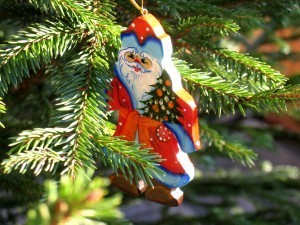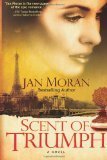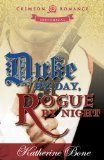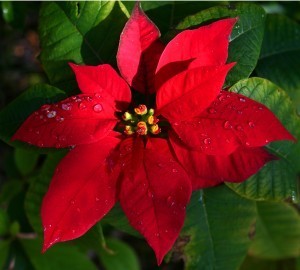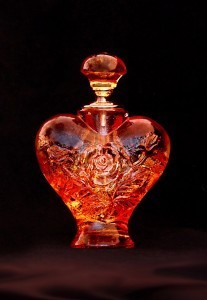Hannah Fielding's Blog, page 140
December 18, 2012
Who wouldn’t want to summer on the French Riviera, with views like this?
 View of the approach to St Tropez. I love the amber warmth of the buildings here, offset against the bluest sky and sea, and verdant greens hills.
View of the approach to St Tropez. I love the amber warmth of the buildings here, offset against the bluest sky and sea, and verdant greens hills.
December 17, 2012
Ten traditional Christmas culinary treats from around the world
If you’re anything like me, at the heart of Christmas is time spent with loved ones – but food is also a key feature of the celebrations. Close your eyes at any time of the year and imagine Christmas, and amid the rich reds of poinsettias and earthy green of the Christmas trees whose needles give off the most wonderful pine scent, I can smell the turkey baking slowly in the oven, taste tart redcurrants, feel the crumble of mince-pie pastry on my tongue. Heavenly!
I love to plan menus for lunches and dinners that we host, starting as early as November, and of course home-baked cakes, biscuits and sweets make ideal, personal gifts for people. Today, I thought I would share with you some favourite Christmas treats from around the world. I hope they inspire you to get creative in the kitchen. Nothing says ‘Christmas’ more than a house filled with the scent of baking delights!
From Chile, Cola de mono (means Monkey’s Tail). The Chilean version of eggnog. It contains aguardiente (firewater), milk, coffee, vanilla and cloves/cinnamon. This will give you a real kick, so it’s an adults-only treat. For a recipe, visit http://www.food.com/recipe/cola-de-mono-tail-of-the-monkey-50828.
From Denmark, æbleskiver. Round, light fluffy pancakes, sprinkled with icing sugar and served with pots of jam for dipping. Often served with hot mulled wine. Take a look at http://allrecipes.com/recipe/aebleskiver/.
From France, the thirteen desserts. In the region of Provence, the French people have a wonderful approach to treats: why stop at one dessert at Christmas time – thirteen sounds much better! The thirteen desserts represent Jesus and the twelve apostles. They are set out on the table on Christmas Eve and are eaten over the course of the holiday period. The thirteen desserts are usually chosen from the following: raisins, walnuts, dried figs, almonds, dates, dried plums, apples, pears, oranges, winter melon, grapes, tangerines, quince cheese and a wide range of sweets, biscuits and breads, including nougat and candied lemon peel. Not quite as exciting, perhaps, as thirteen cheesecakes, pies and pavlovas – but you could always adopt the idea as you like for your own household!
From Germany, Pfefferkuchenhaus. The gingerbread house of the Hänsel und Gretel fairy tale, made with ginger and molasses or treacle and decorated with sweets and icing. Search Google Images for ‘Pfefferkuchenhaus’ to get some wonderful ideas for designs.
From Italy, panettone. Light and fluffy with a unique flavour, with a range of flavourings, from orange and lemon zest to chocolate and raisins. Serve with crema di mascarpone – mascarpone, eggs and amaretto. Not an easy one to bake at home, but plenty of shops sell wonderful imported cakes.
From Japan, their traditional Christmas cake: sponge cake with white-cream frosting, topped with fresh strawberries and a ‘Merry Christmas’ chocolate plate.
From Mexico, ponche. A hot drink made from apples, prunes, sugar cane and Mexican hawthorn, with a slug of tequila or rum. It’s wonderfully sweet and warming. Make it for yourself with this recipe: http://www.themijachronicles.com/2010/12/how-to-make-ponche-the-traditional-mexican-christmas-punch/.
From Spain, turrón. It’s a popular type of nougat made with honey, sugar and egg whites, usually with almonds. I especially love the chocolate-coated variety. See http://www.food.com/recipe/turron-de-alicante-almond-nougat-253292.
From Sweden, glögg. The Nordic version of mulled wine, comprising red wine, sugar and spices like cinnamon, cardamom, ginger, cloves, and bitter orange. Some people add spirits such as vodka and brandy as well. The wine is left to infuse for an hour after heating, and then reheated to serve. Delicious with ginger snaps.
From Britain, mince pies. Puff or shortcrust – lattice-topped or closed – simple mincemeat or with a dash of rum or sherry. Mince pies are a staple in the British cuisine come December, and they’re wonderfully simple to make at home (especially if you cheat and buy a jar of mincemeat and ready-to-roll pastry!). Just beware; mince pies fresh from the oven are wolves in sheep’s clothing – warm on the outside but scorching hot within!
December 15, 2012
Having faith in a little magic
As Christmas approaches, parents worldwide struggle with a difficult issue: will this be the year that their child stops believing in Santa Claus?
Of course the time comes when a child’s logic wins out over their imagination: when they realise that the man in the Santa costume who’s visiting their school is wearing the exact same shoes as their maths teacher; when explanations of quite how Santa manages to get around all the houses in the world don’t quite add up; when a child asks brightly, ‘How come Santa’s used the same wrapping paper for his presents as you have on those you’ve given to me?’
The realisation that Santa – or the Easter Bunny, or the Tooth Fairy – doesn’t exist is a seminal moment in childhood, and one many parents hope to put off for as long as possible. Don’t we all remember the sadness of discovering that the world is a less wonderful, sparkling, twinkling place than we’d imagined since we were even capable of imagining? Growing up is not easy, and even as an adult we often yearn for the simplicity and innocence of childhood.
I think the reason that we love Christmas so much is the magic in the air – and being around children who do believe heightens the experience. But I wonder whether, if we allow ourselves, children have a lesson to teach us at this time of year…
For at the root of Christmas is one core value: Faith. It’s what children have in abundance, and adults – hurt by the realities and difficulties of life – often struggle to embrace.
Those of us who write and read romance, of course, are much attuned to the magical, atmospheric, sensation-stirring side of life. And when I write romance, such as in my novel Burning Embers, I always think the climax of a book boils down to two people who love each other taking a leap of faith – to trust each other, to trust their feelings, to trust this thing called ‘love’ that is intangible and yet is the most powerful force on Earth.
Faith – belief in just a touch of magic – may be a difficult path for a reasoned adult to tread. But oh how much lighter one treads with a heart that contains hope and belief.
So this holiday season, I wish you all a truly magical Christmas, in every sense.
December 14, 2012
Book Review: Scent of Triumph by Jan Moran
From the blurb:
Scent of Triumph is the story of Danielle Bretancourt, a talented young French perfumer with a flair for fashion and a natural olfactory gift. In the language of perfumery, she is a Nose, with the rare ability to recognize thousands of essences by memory. The story opens on the day England declares war on Germany, and Danielle and her family are caught in the midst of a raging disaster sweeping across Europe.
Her life takes a tragic turn when Nazis murder her husband and their only son is stranded behind enemy lines. She spies for the French resistance, determined to find him, but is forced to flee Europe with fragments of her family. Destitute, she mines her talents to create a magnificent perfume that captures the hearts of Hollywood’s top stars, then gambles again to win wealth and success as a couturier. Her intelligence and flair attracts the adoration of Jonathan Newell-Grey, of England’s top shipping conglomerate, and Cameron Murphy, Hollywood’s most charismatic star.
Danielle charts her course through devastating wartime losses and revenge; lustful lovers and loveless marriages; and valiant struggles to reunite her family. Set between privileged lifestyles and gritty realities, here is one woman’s story of courage, spirit, and resilience.
One word to describe the book: divine. Such a pleasurable few days I spent lost in this fictional world.
The plot is deeply moving and feels very realistically – hauntingly so when it comes to events related to loss and the war. There’s good pace, and plenty of suspense to keep you wanting to turn the pages. I was quite caught up in the story, to the point that I was tearful on several occasions. And such a marvellous ending!
I felt enormously empathetic towards Danielle, the protagonist. She’s mature, courageous, hard-working, sensible and fiercely independent – all qualities that make her easy to like. This is not a heroine bowed down by adversity, but one who turns it to her advantage. I was especially drawn to her relationships with people – as a mother and daughter, and as a wife. There’s a compelling realism in these relationships that stands out in the writing. When a main character is so human – full of unrealised passions, doing her best with her lot while yearning for more – it is a recipe for a book that really touches the core of the reader.
I adored the themes of fashion and scent that are explored in the book, and the glimpses of life in the upper classes and Hollywood elite. There is such a sense of wartime and post-war Europe and America, and I felt transported back in time as I read. I could imagine the scenes and the people with amazing clarity.
For me, the best part of the book is the sublime description which very deliberately appeals to the sense of smell, as in the following:
Danielle gazed out of the window. She shook her hair in the cool breeze and inhaled, the scents of lavender and rose and jasmine sweet in the lucent air. To her, these were the aromas of creativity, of freedom, where she’d always been happiest.
In my own writing I always describe in such a way that the reader can see and hear and taste and feel and smell the details of a setting, and I felt a real affinity to Jan’s way of writing. Indeed, by the end of the book I would swear I could smell Danielle’s famous creation, the perfume Chimère. The author has such a wealth of understanding of beauty and scent which comes across in the book, and I found myself visiting her website (http://janmoran.com) when I finished reading, keen to learn more about her. I was delighted to find that she has a book out called Fabulous Fragrances that explores the stories behind 350 prestige perfumes – fascinating!
In sum, I count myself a Jan Moran fan now and I eagerly anticipate her next novel, which I’ve no doubt will be ‘scentsational’…
Scent of Triumph is available now from Amazon; click on the book cover below to visit the store.
Book Review: Duke by Day, Rogue by Night by Katherine Bone
From the blurb:
Constance Danbury is fleeing an arranged marriage to lecherous Lord Burton, a man who has blackmailed her father and is nearly twice her age. Her escape takes her aboard a merchantman bound for Spain, where she hopes an aunt will help her procure funds to save her father’s dwindling reputation. But fate intervenes. Constance is captured by a pirate with a wit and stubbornness to match her own, and a secret he’ll do anything to keep.
Nobleman Percival Avery is a member of Nelson’s Tea, an elite group whose members are first sons from every tier in society. Undercover, he disguises himself as a pirate to infiltrate the gang of cutthroats responsible for his sister’s death. But when his vessel attacks a merchantman with valuable cargo, Percy is forced to choose between vengeance and saving the life of his commander’s niece, Constance Danbury. Mutiny is sure to obliterate his well-laid plans. It also aligns him with the one woman sure to see through his disguise. Forced to play the fop by day to outwit his enemies, he masquerades as a rogue by night in order to avenge his sister’s death – and to win his true love’s heart.
In her debut novel Katherine Bone drops you right into the action aboard a merchant ship bound for Spain that is being attacked by pirates, setting the pace for the rest of the book, which is filled with adventure, mystery, passion and romance. Set during the Napoleonic wars of the early nineteenth century, this book uses some of the amazing seafaring characters of this classic British historical era – pirates, merchants, naval officers and Nelson’s own double agents. But not all of the action takes place on the high seas of the English Channel, because the main characters return to London – to the grimy, violent patrons of the docks and its local public houses and to the aristocratic finesse and extravagance of the London Ton, dancing in balls and driving in the park.
The pace of this book is fast pretty much throughout; it is a page turner that keeps you asking what is going to happen next, will they work it out, will they survive, will they kiss…? The mystery of who killed Percival’s sister and the double agents in the book mean that there are many twists and turns that keep you guessing. Added to that an apparent love triangle between a lady, a pirate and a nobleman and you can’t put the book down. Is she going to work out their connection, or is he going to tell her?
Yet how was it her body ignited beneath her enemy’s caress when Burton’s touch filled her with horrible misgivings? Surely the opposite should be true. Burton was a member of the ton, the pirate wasn’t. Was she doomed to end up on the streets, cast out of society? She couldn’t allow it to happen. She needed a plan.
Katherine Bones paints a world rich in intrigue. Told from a range of perspectives, the book enables the reader to really feel for the main characters. You cannot help but cheer on the fiery lead female character, Constance, who wants to marry for love, not duty or money, and is prepared to risk her own life to do so. Who would want to marry the ghastly Lord Burton, who believes women are there to be used and discarded? You can’t help but fall in love with the two alter egos of Percival Avery either – pirate and gentleman. You hope that the frightful Lord Burton and the horrendous pirates get their comeuppance, and you are left intrigued by Henry Gruffald – ideal because he is the lead of Katherine’s next book, which I very much look forward to reading.
Duke by Day, Rogue by Night is available now from Amazon; click on the book cover below to visit the store.
December 13, 2012
How my French/English upbringing informs my writing: A video interview
December 11, 2012
A dreamlike view from my house in France
 I love skies like these. I will happily sit out on the terrace for an hour, just gazing up and dreaming.
I love skies like these. I will happily sit out on the terrace for an hour, just gazing up and dreaming.
December 10, 2012
The meaning of flowers
One of my hobbies is flower arranging. In my gardens in Kent and France I grow a wide variety of flowers, and I love to brighten and fragrance a room with a vase of freshly cut flowers. There is such simple beauty in a flower, and I find that even the gloomiest day can be lightened with a rose or a lily or an orchid.
In addition, like most women, I love to give and to receive flowers. How my face lights up when I’m presented with a bouquet. But beyond the beauty of a posy, I find the significance of the flowers fascinating. Did you know that traditionally meanings are attributed to different flowers? Floriography, the language of flowers, extends back in history to the times of the Ancient Greeks, Romans, Egyptians and Chinese.
Here’s an overview of the floriography of some common flowers, so that next time you’re making an arrangement or choosing a bouquet or opening your arms to a bunch of flowers, you know the thinking behind each petal and stem.
Baby’s Breath – happiness
Carnation (Red) – admiration of the heart
Carnation (Pink) – remembrance
Carnation (White) – chasteness
Chrysanthemum (White) – truth
Chrysanthemum (White) – reciprocated love
Daisy – gentleness, innocence and loyalty
Daffodil – respect, unrequited love
Heather – admiration
Iris – faith, friendship
Ivy –fidelity, love, friendship and affection
Jasmine – happiness, cheerfulness
Laurel – success in love
Lily (White) – modesty, purity
Lily (Orange) – passion
Mistletoe – affection or love
Orchid – show love, beauty and magnificence.
Rose (Coral) – desire
Rose (Light Pink) – admiration
Rose (Pale Pink) – friendship
Rose (Pink) – happiness.
Rose (Red) – love, desire
Rose (White) – charming, heavenly
Rose (Yellow) – friendship, happiness
Tulip – perfect love
Whatever flower you choose or receive, the message of love is predominant – from a toddler picking a daisy for his mother to a husband arriving home with a bouquet for his wife. That’s why, I think, no one can deny the wonder of flowers, and why we all appreciate the beauty of spring, when the first flowers push up from the barren ground to bring colour and fragrance to the world.
If you’re arranging flowers this month, the following are considered December’s flowers: poinsettia, Holly, Narcissus, Paperwhite. I love Poinsettias for their wonderful warm, passionate colours. As a symbol, they mean good cheer and success, making them an excellent gift for friends at Christmas.
December 9, 2012
I’m delighted to be taking part in the Orangeberry Virtua...
Check out my author page here for an outline of the many blogs I’ll be featuring on: http://blog.orangeberrypromo.com/2012/10/virtual-book-expo-hannah-fielding/






December 8, 2012
‘Love-scent’ descriptions
This week I read a wonderful book by fragrance lover Jan Moran called Scent of Triumph (review to follow on the blog this week) in which perfume and the aromas of nature feature heavily. The book struck a chord with me because I have always felt scents have such power to transport one to different times and places, and they are so interconnected with memory and emotion. Freshly brewed coffee can take you back to a cosy afternoon spent with a dear friend in café; the heady scent of bougainvillea can call to mind a lazy summer’s afternoon reading a book in the garden; a waft of cologne from a man passing in the street can bring to your mind the embrace of a lover.
My novel, Burning Embers, is set in 1970s Kenya, and when I came to write the book I used as a basis for setting descriptions my experience of visiting the country as a young woman. When I closed my mind and recalled the place, along with the bright colours and distinctive sounds I found myself remembering scents. Because I wanted my reader to also know the place, I was careful to include those fragrance memories in my writing, as in the following:
The air was heavy with redolent scents. It was all coming back to her now: the blend of tar, sea, ropes, moldy timber, spices, and dry fish that haunts every port but which Coral mentally associated with Kenya and her childhood.
…
Surrounded by a high wall of hedges, a narrow wooden gate marked its entrance and the beginning of the scented walk into the center of the enclosure. The dappled tunnel of classic arches, overgrown with white honeysuckle and delicate pink trumpet vines, led to the Roman-inspired pavilion at the center where the altar had been set up. Artifact containers were dotted around the enclosure, spilling over with a profusion of sweet-smelling white flowers and greenery, adding lush fragrance to the surroundings.
…
There was a vague smell of decay mingled with the balsamic odor of precious woods and resin that the witch doctor was burning.
But beyond the description of the setting, I have always felt that the sense of smell is key in attraction between two people. Scientists talk of pheromones and chemical compatibility conveyed through scent, and the popularity of the fragrance industry bears testament to the fact that it is how a person smells to you, as much as how they look and sound and feel and act, that creates a need to be close. And so Rafe finds Coral’s scent alluring: ‘Rafe leaned in to whisper in Coral’s ear, and she felt him breathe in her scent like a man thirsting in the desert who had finally found water.’ And Coral is similarly affected by Rafe’s scent: ‘As he stepped back to let her pass, a whiff of cologne that mingled with the clean, manly scent of his skin tickled her nostrils, sending unwelcome tremors through her body.’
One of my favourite interactions in dialogue between Rafe and Coral in the book is when Coral, having been invited on a date with Rafe, asks, ‘What should I wear?’ His response is simple and sensual, ‘Your favorite scent and a smile.’
What is fascinating about scent, I think, is that we all have unique individual interpretations and preferences. One person’s heaven is another’s poison. One person smells nothing much; another a plethora of intermingled scents. One person smells freshly cut grass, another autumn leaves. One woman’s perfume smells floral and delicate, yet on another’s wrist it is muskier, headier.
There are so many scents, with so many meanings, but that which carries you to a place of passion and love is the most powerful. Do you agree? What is your favourite perfume? How do you love a partner to smell? I would love to hear your thoughts.


